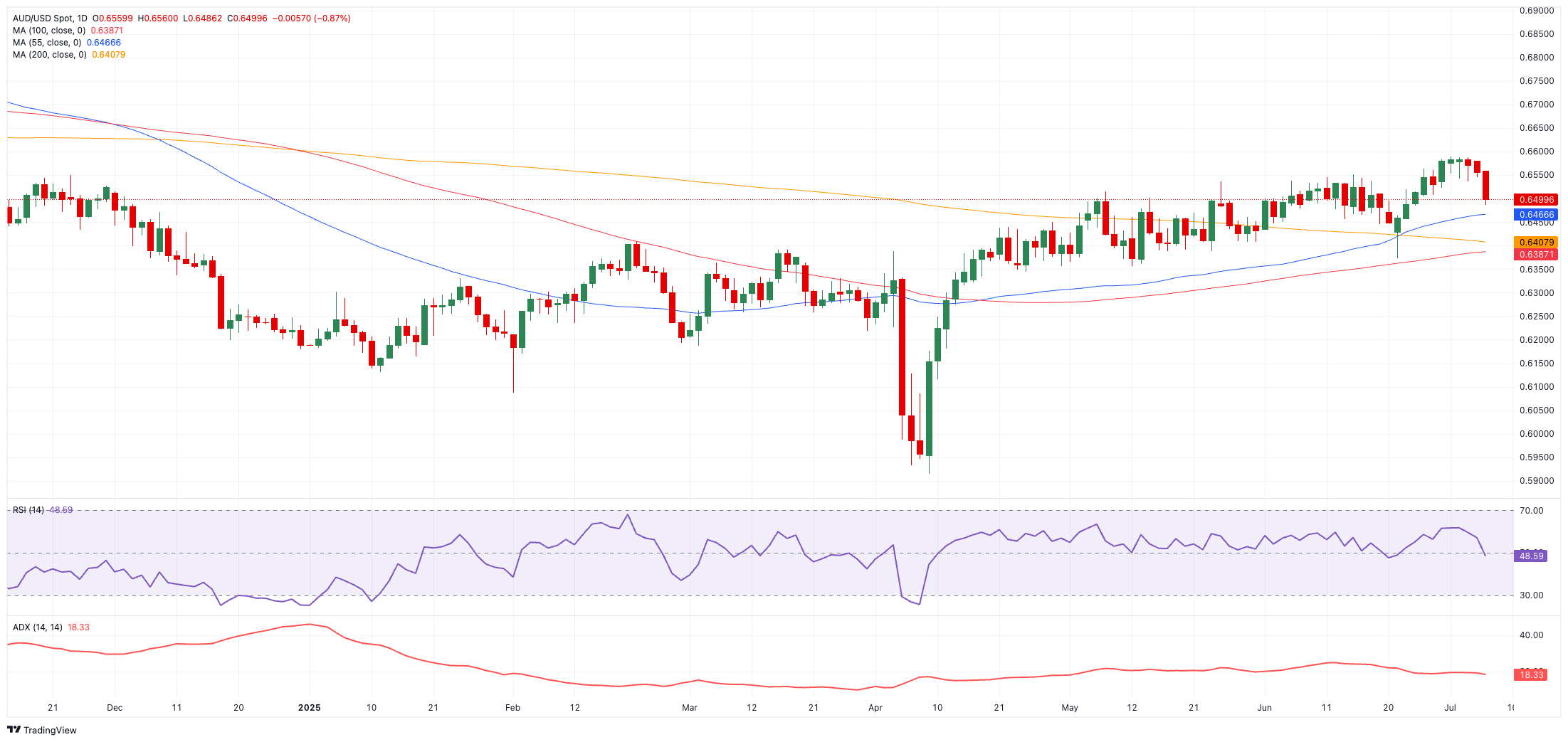
- AUD/USD added to the ongoing correction and broke below 0.6500.
- The US Dollar remained bid on trade concerns and safe-haven flows.
- The RBA is largely expected to lower its OCR by 25 basis points on Tuesday.
The Australian Dollar (AUD) added to the current leg lower vs. the US Dollar (USD) in quite a gloomy start to the new trading week. Indeed, AUD/USD came under heightened downside pressure, briefly piercing the 0.6500 support to hit multi-day troughs near 0.6480 against the backdrop of a broad-based offered stance in the risk-linked universe.
China’s outlook remains far from clear
China, Australia’s largest trading partner, delivered a mixed but broadly encouraging update.
In fact, May’s industrial output, retail sales, and service activity all accelerated, underpinning forecasts for around 5% annualised GDP growth. Additionally, June’s official PMI readings showed manufacturing at 49.7 and non-manufacturing at 50.5, while Caixin’s manufacturing PMI rose to 50.4 and the services PMI ticked down to 50.6.
However, persistent strains in the property sector and the gradual withdrawal of stimulus may weigh on growth later in the year, potentially emerging as a headwind for the Aussie.
Central banks opposite paths
Divergent monetary policies continue to be a key factor influencing the current market conditions.
That said, the Reserve Bank of Australia (RBA) cut its cash rate by 25 basis points to 3.85% at its June meeting, signalling a gradual descent to 3.20% by 2027. So far, market consensus appears pretty convinced that the central bank will further lower its OCR by another quarter point at its July 8 event.
In contrast, the Federal Reserve (Fed) held rates steady in June but reaffirmed guidance for two 50-basis-point cuts by year-end, with Chair Jerome Powell warning that US tariffs could rekindle goods inflation.
What’s next for AUD/USD
The RBA will meet on July 8, followed by Governor Michele Bullock’s press conference and the NAB Business Confidence. Later in the week, the focus will shift to the housing sector with the release of Building Permits and Private House Approvals.
Technical outlook
Immediate resistance sits at the 2025 ceiling of 0.6590 (June 30), with the November 2024 high of 0.6687 (November 7) and the psychological 0.7000 level awaiting further advances.
On the downside, the 200-day simple moving average (SMA) at 0.6413 offers initial support ahead of the June trough of 0.6372 (June 23) and the May low of 0.6356 (May 12). A breach below this level could expose the 0.6000 milestone and the 2025 bottom of 0.5913 (April 9).
Momentum indicators paint a mixed picture: the Relative Strength Index (RSI), just below the 50 threshold, hints at further downside, while an Average Directional Index (ADX) nearly 20 suggests a moderately firm trend.
AUD/USD daily chart

To sum up
The AUD/USD appears to have encountered significant resistance in the 0.6600 region for now.
The most crucial uncertainties are Beijing’s policy mix and any unexpected changes in US trade settings, both of which do not seem to be on the horizon at now.
Markets are bracing for a possible minor RBA reduction later this year, with expectations that the bank would take a cautious approach rather than launch an aggressive lowering cycle.
In summary, unless there is an unforeseen external effect, the Australian Dollar’s bullish outlook looks to be sustainable in the medium term, with modest rises projected as long as it continues above its 200-day SMA.
RBA FAQs
The Reserve Bank of Australia (RBA) sets interest rates and manages monetary policy for Australia. Decisions are made by a board of governors at 11 meetings a year and ad hoc emergency meetings as required. The RBA’s primary mandate is to maintain price stability, which means an inflation rate of 2-3%, but also “..to contribute to the stability of the currency, full employment, and the economic prosperity and welfare of the Australian people.” Its main tool for achieving this is by raising or lowering interest rates. Relatively high interest rates will strengthen the Australian Dollar (AUD) and vice versa. Other RBA tools include quantitative easing and tightening.
While inflation had always traditionally been thought of as a negative factor for currencies since it lowers the value of money in general, the opposite has actually been the case in modern times with the relaxation of cross-border capital controls. Moderately higher inflation now tends to lead central banks to put up their interest rates, which in turn has the effect of attracting more capital inflows from global investors seeking a lucrative place to keep their money. This increases demand for the local currency, which in the case of Australia is the Aussie Dollar.
Macroeconomic data gauges the health of an economy and can have an impact on the value of its currency. Investors prefer to invest their capital in economies that are safe and growing rather than precarious and shrinking. Greater capital inflows increase the aggregate demand and value of the domestic currency. Classic indicators, such as GDP, Manufacturing and Services PMIs, employment, and consumer sentiment surveys can influence AUD. A strong economy may encourage the Reserve Bank of Australia to put up interest rates, also supporting AUD.
Quantitative Easing (QE) is a tool used in extreme situations when lowering interest rates is not enough to restore the flow of credit in the economy. QE is the process by which the Reserve Bank of Australia (RBA) prints Australian Dollars (AUD) for the purpose of buying assets – usually government or corporate bonds – from financial institutions, thereby providing them with much-needed liquidity. QE usually results in a weaker AUD.
Quantitative tightening (QT) is the reverse of QE. It is undertaken after QE when an economic recovery is underway and inflation starts rising. Whilst in QE the Reserve Bank of Australia (RBA) purchases government and corporate bonds from financial institutions to provide them with liquidity, in QT the RBA stops buying more assets, and stops reinvesting the principal maturing on the bonds it already holds. It would be positive (or bullish) for the Australian Dollar.
Information on these pages contains forward-looking statements that involve risks and uncertainties. Markets and instruments profiled on this page are for informational purposes only and should not in any way come across as a recommendation to buy or sell in these assets. You should do your own thorough research before making any investment decisions. FXStreet does not in any way guarantee that this information is free from mistakes, errors, or material misstatements. It also does not guarantee that this information is of a timely nature. Investing in Open Markets involves a great deal of risk, including the loss of all or a portion of your investment, as well as emotional distress. All risks, losses and costs associated with investing, including total loss of principal, are your responsibility. The views and opinions expressed in this article are those of the authors and do not necessarily reflect the official policy or position of FXStreet nor its advertisers. The author will not be held responsible for information that is found at the end of links posted on this page.
If not otherwise explicitly mentioned in the body of the article, at the time of writing, the author has no position in any stock mentioned in this article and no business relationship with any company mentioned. The author has not received compensation for writing this article, other than from FXStreet.
FXStreet and the author do not provide personalized recommendations. The author makes no representations as to the accuracy, completeness, or suitability of this information. FXStreet and the author will not be liable for any errors, omissions or any losses, injuries or damages arising from this information and its display or use. Errors and omissions excepted.
The author and FXStreet are not registered investment advisors and nothing in this article is intended to be investment advice.








